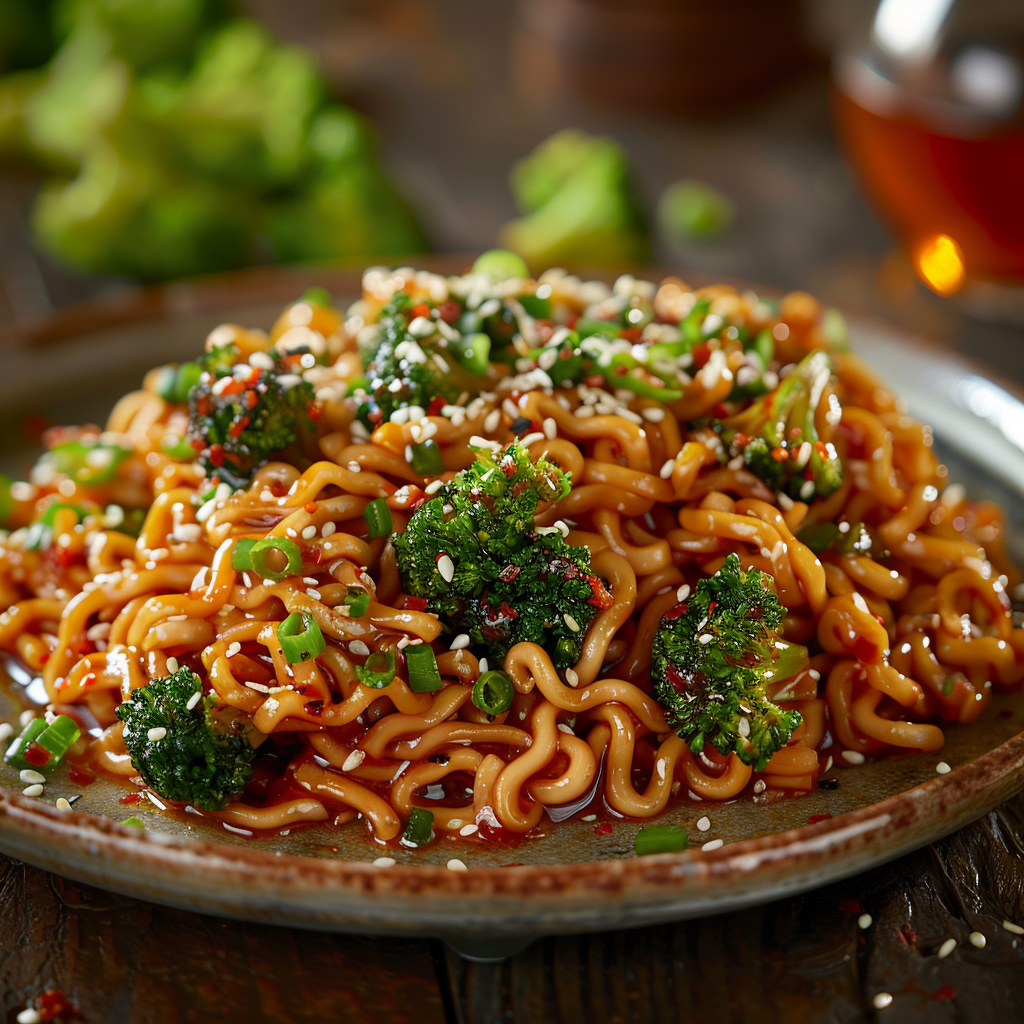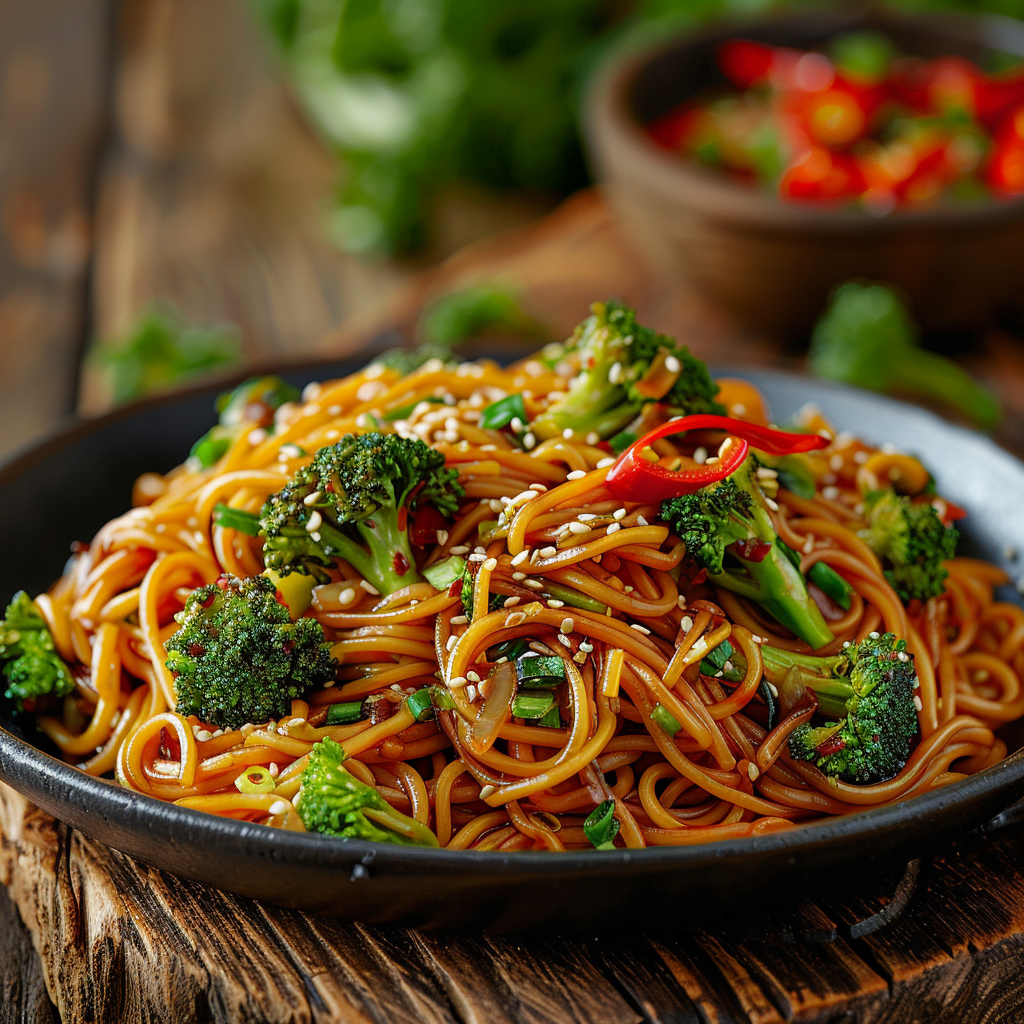Why You’ll Love This Dish
Let me tell you about the first time I made mongolian noodles. It was a chilly Sunday afternoon, and my kitchen smelled like garlic, ginger, and soy sauce. My kids were skeptical at first—what’s this orange-colored noodle thing, Mom? But one bite later, they were hooked. The chewy noodles coated in that glossy, savory sauce are pure comfort food. Whether you’re looking for a quick weeknight meal or something to impress guests, this dish has your back.
A Little History Behind Mongolian Noodles
You might be wondering, what’s the deal with mongolian noodles name? Despite its name, this dish isn’t exactly from Mongolia. It’s more of a fusion creation inspired by Asian flavors. Traditional mongolian noodles often feature hearty ingredients like beef or lamb, but these days, there are plenty of vegetarian versions too. I tested out a mongolian noodles recipe vegetarian version recently, swapping meat for tofu and veggies. Trust me, it’s just as delicious!
Why This Recipe Rocks
This recipe is all about balance. The sauce is rich but not overwhelming, with hints of sweetness and spice. Plus, it comes together in under 30 minutes, making it perfect for busy nights. If you’re counting calories, don’t worry—mongolian noodles calories aren’t sky-high if you use lean proteins and load up on veggies. And if you’re craving takeout, why not try making it yourself? Skip searching “mongolian noodles near me” and whip up this homemade version instead.
When to Make Mongolian Noodles
These noodles are versatile. Serve them at a casual family dinner, bring them to a potluck, or even make them for date night. They’re also great for feeding a crowd because you can easily double the recipe. Looking for something spicy? Try adding extra chili flakes for spicy mongolian noodles.
Ingredients
- 8 oz fresh or dried noodles (egg noodles work well)
- 2 tbsp vegetable oil
- 1 lb thinly sliced beef, chicken, or tofu
- 3 cloves garlic, minced
- 1 tbsp grated ginger
- 1 red bell pepper, sliced
- 1 cup broccoli florets
- 3 tbsp soy sauce
- 2 tbsp hoisin sauce
- 1 tbsp brown sugar
- ½ tsp red pepper flakes (optional)
- Green onions for garnish
Substitution Options
- Swap beef for chicken, pork, shrimp, or tofu.
- Use zucchini noodles for a low-carb option.
- Replace hoisin sauce with oyster sauce if needed.
Step 1: Cook the Noodles
Start by boiling water in a large pot. Add your noodles and cook until al dente. Fresh noodles will take just a few minutes, while dried ones need a bit longer. Drain them and set aside. Pro tip: Toss the cooked noodles with a splash of oil to prevent sticking.
Step 2: Sear the Protein
Heat some oil in a skillet over medium-high heat. Add your protein—beef, chicken, or tofu—and cook until golden brown. Remove it from the pan and keep it warm. The sizzle of the meat hitting the hot pan is music to my ears. Don’t overcrowd the skillet; otherwise, it won’t sear properly.
Step 3: Sauté the Veggies
In the same skillet, add garlic and ginger. Stir for about 30 seconds until fragrant. Then toss in the bell peppers and broccoli. These colorful veggies add crunch and freshness to the dish. Keep stirring until they’re tender-crisp.
Step 4: Make the Sauce
Combine soy sauce, hoisin sauce, brown sugar, and red pepper flakes in a small bowl. Pour this mixture into the skillet with the veggies. Let it simmer for a minute until the sauce thickens slightly. The aroma at this stage is heavenly—a mix of sweet, salty, and umami goodness.
Step 5: Combine Everything
Add the cooked noodles and protein back into the skillet. Toss everything together until the noodles are evenly coated in the sauce. Garnish with chopped green onions before serving. Chef’s tip: A squeeze of lime juice right before serving adds brightness to the dish.
Timing
- Prep Time: 10 minutes
- Cooking Time: 15 minutes
- Total Time: 25 minutes
Chef’s Secret
To answer the question, “Why are Mongolian noodles orange?,” it’s mostly due to the hoisin sauce. For an authentic touch, toast your ginger and garlic briefly before adding other ingredients—it enhances their flavor.
Extra Info
Did you know that traditional mongolian noodles often include hand-pulled noodles? While we’re using store-bought here, you can experiment with making your own if you’re feeling adventurous.
Necessary Equipment
- Large pot for boiling noodles
- Skillet or wok
- Wooden spoon or spatula
- Measuring spoons and cups
Storage
If you have leftovers, let them cool completely before storing. Transfer the noodles to an airtight container and refrigerate for up to three days. Reheat in a skillet with a splash of water to revive the texture.
Freezing isn’t ideal for this dish because the noodles can become mushy when thawed. However, you can freeze the sauce separately and mix it with freshly cooked noodles later.
For best results, enjoy the dish fresh. It tastes better straight off the stove when the flavors are vibrant and the noodles are still springy.
Tips and Advice
- Don’t overcook the noodles—they should remain slightly firm.
- Use high heat when cooking to achieve that signature char.
- Adjust the sweetness and spiciness to suit your taste.
Presentation Tips
- Serve in a wide bowl to showcase the colorful veggies.
- Garnish with sesame seeds or crushed peanuts for crunch.
- Add a sprig of cilantro for a pop of green.
Healthier Alternatives
Here are six ways to lighten up your mongolian noodles:
- Zoodle Swap: Use spiralized zucchini instead of regular noodles.
- Lean Proteins: Opt for turkey breast or plant-based proteins.
- Low-Sodium Sauce: Choose reduced-sodium soy sauce.
- Veggie Boost: Add spinach, mushrooms, or snap peas.
- Less Sugar: Cut the brown sugar in half.
- Air Fryer Tofu: Crispy tofu makes a fantastic topping.
Mistake 1: Overcooking the Noodles
Overcooked noodles turn mushy and ruin the texture of the dish. To avoid this, check the package instructions and taste-test a noodle before draining. Pro tip: Rinse the noodles under cold water to stop the cooking process.
Mistake 2: Skipping the Sauce Balance
The magic of mongolian noodles lies in its sauce. Too much soy sauce makes it overly salty, while too little leaves it bland. Measure carefully and adjust seasonings gradually.
Mistake 3: Crowding the Pan
Crowding the pan lowers the temperature and prevents proper browning. Cook in batches if necessary. This ensures each piece gets that beautiful caramelization.
FAQ
What Are Mongolian Noodles Made Of?
Mongolian noodles typically consist of wheat-based noodles stir-fried with a savory sauce made from soy sauce, hoisin sauce, garlic, ginger, and sometimes a touch of brown sugar. Vegetables and protein are added for variety.
What Do Mongolian Noodles Taste Like?
They have a rich, umami flavor with notes of sweetness and spice. The sauce clings to the chewy noodles, creating a satisfying mouthfeel.
What Is Mongolian Sauce Made Of?
Mongolian sauce combines soy sauce, hoisin sauce, garlic, ginger, brown sugar, and red pepper flakes. It’s simple yet packed with flavor.
Can I Find Mongolian Noodles Near Me?
Check local Asian restaurants or grocery stores. Alternatively, search online for delivery options or recipes to make it at home.
How Many Calories Are in Mongolian Noodles?
Calories vary based on portion size and ingredients. On average, a serving contains around 400-500 calories.
Is There a Vegetarian Version Available?
Absolutely! Substitute tofu or tempeh for meat and load up on veggies.
Where Can I Learn More About Mongolian Noodles Wiki?
Online resources provide detailed histories and variations of the dish.
Are Spicy Mongolian Noodles Common?
Yes, many people love adding extra heat with chili flakes or sriracha.
What Makes Mongolian Noodles Orange?
Hoisin sauce gives the dish its distinctive orange hue.
Can I Use Store-Bought Sauce?
Yes, but homemade sauce tastes fresher and allows for customization.
Final Thoughts
There you have it—everything you need to master mongolian noodles. From its rich history to tips for perfecting the recipe, this dish is sure to become a staple in your kitchen. So grab those ingredients and get cooking. Your family will thank you!

Mongolian Noodles
Ingredients
Equipment
Method
- Boil water in a large pot and cook the noodles until al dente. Drain and toss with a splash of oil to prevent sticking.
- Heat oil in a skillet over medium-high heat. Add your protein and cook until golden brown, then remove and keep warm.
- In the same skillet, add garlic and ginger, stirring for 30 seconds. Then add the bell peppers and broccoli, cooking until tender-crisp.
- Combine soy sauce, hoisin sauce, brown sugar, and red pepper flakes in a bowl. Pour into the skillet with veggies and simmer for a minute until slightly thickened.
- Add the cooked noodles and protein back into the skillet, tossing until the noodles are evenly coated in the sauce. Garnish with chopped green onions before serving.



